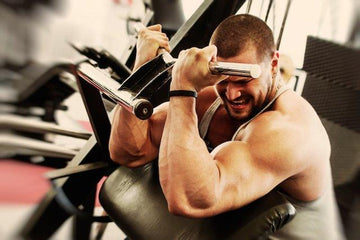

Training Explosive Style: Increase your Power, Size, and Speed
Table of Contents
Training Explosive Style: Increase your Power, Size, and Speed
by: Joe Palumbo
Explosive training is a high intensity training technique that appeals to a great number of strength and conditioning coaches, professional athletes, and athletic trainers. Performing exercises in an explosive manner has been shown to produce favorable results in terms of athletic performance. The main principle of explosive exercise is to improve the ability to generate Power and Strength to equal Speed. Simply put, the goal of explosive training is to move heavy weights or objects (power & strength) quickly (speed). When you think of power lifters, I am sure that strength comes to mind, and when you think of sprinters, you think of speed. Yet power lifters and sprinters are two entirely different sports that benefit from the same training technique, explosive training. Olympic Sprinters need to generate that “BURST” of power right at the starting line. Football players have been using this type of training for years as well as many other professional sports. Whatever your sport, using an Explosive training technique will help you efficiently achieve your athletic potential. Olympic lifts and Plyometrics movement are the keys to Power and Explosiveness. By combining Olympic lifts and a Plyometric training program, you will be well on your way to developing fast, explosive power.
Before adding power exercises into your routine, it’s crucial to have proper form and technique. Because these exercises are so quick and explosive, they require the body to produce and absorb a tremendous amount of force. Explosive lifts like the clean and jerk also require an enormous amount of coordination. To master proper form and avoid injury, the lifts should be performed with light weight for a high volume of reps before adding any substantial load.

CLEAN AND JERK
One of the most common Olympic lifts is the Clean and Jerk; it is a multi-movement lift. There are two parts in this exercise; the first part of the movement is the Clean. During the clean phase, you will lift the barbell from the floor to the shoulders and rack it on the clavicle in one continuous explosive movement; the second movement is the Jerk; in this movement, the barbell is driven from the shoulders to arms length overhead. The lift is complete when the feet are in line and the bar under control.
PREPARATION
Position a barbell with weights on the ground in front of you. Place your feet flat on the floor about hip wide under the bar. Squat down and grip the bar with an over hand grips slightly wider than shoulder width. Shoulders over the bar with back tight and slightly arched arms straight and firm, head facing forward and inhale.
EXECUTION -The Clean
Pull the bar off the floor by forcefully extending the hips and knees, keep the shoulders in front of the bar and keep the bar close to your body. As the bar reaches the knees, vigorously raise the shoulders while keeping the bar close to your thighs. Jump upward extending the body, shrug the shoulders and pull the bar upward with arms straight and flex the elbows out to the sides, pull your body under the bar as you raise it while rotating the elbows around the bar. Catch the bar on the shoulders while moving into a squat position, keep your head up and torso thigh, and exhale as you’re standing up. Drop your hips into a squat position. The arms will act to pull you under the barbell and will bend slightly. Catch the barbell in the rack position where the bar sits on the top of your chest and shoulders. The rack position is essential for continuing the clean and jerk with an efficient jerk movement. Stand up out of the squat and keep the barbell in the racked position.
EXPLODE- The Jerk Make breathing and grip adjustments if necessary hold the chest high, elbows to
Make breathing and grip adjustments if necessary hold the chest high, elbows to
the front, inhale, keep your core tight, then quickly DIP straight down about 6
inches by bending the knees and ankles, forcefully drive upward with legs, explosively driving the barbell off the shoulders and splitting the legs (like a lunge position, one foot forward and the other backward simultaneously with speed) while forcefully extending the arms overhead, maintain control, then bring both feet together, push off the front leg and take one step back, push off the back leg and take one step forward, the lift is completed.
Note; do not jerk the weight from the floor, arise steadily then accelerate. For beginners, start out mimicking the lift exercise movement with only a barbell; add weight only when you feel convertible that you have learned the technique.
The other important exercise is the Plyometric movement. Plyometric exercises are considered to help bridge the gap between strength and speed by developing the stretch reflexes, which in turn will help in developing more powerful muscles, greater balance, coordination, agility, and speed. European athletes have capitalized on this exercise for many years. They are many variations of Plyometric exercises and levels of intentions. For this article, I will stick with the basics for power and speed.
PLYOMETRICS
BOX JUMP
1. Stand facing the box with feet slightly wider than hip-width apart.
2. Lower body into a semi-squat position and immediately jump up onto the box. Do not hold a squat position before jumping up – keep the time between dipping down and jumping up to a minimum.
3. Feet should land softly on the box. Step back down and repeat.
Goal 3 sets of 6 – 10 jumps reps
Note. Concentrate on the feet positions when jumping and landing, try to keep the heels off the ground when landing
LATERAL BOX JUMP
1. Stand on a side of the jump box with feet slightly wider than hip-width apart.
2. Lower body into a semi-squat position and jump up onto the box. Do not hold a squat position before jumping up – keep the time between dipping down and jumping up to a minimum.
Feet should land softly on the box, step back down, and repeat.
4. Pause; take a minute or two to recover
5. Stand on the other side of box and repeat the same
Goal 4 sets (2 sets on each side) of 6 – 10 jumps reps
Note; When performing the jumps, execution is critical, if they are not done with maximum effort and speed, the training effect will not be optimal, it is important to warm up first, then stretch your body, (an excellent way to warm up for Plyometric is jumping rope exercises). It’s imperative that you train at the level of your fitness ability. As you master the technique becoming stronger and faster, increase the size (height) of the box or the bench, and the intensity level accordingly.

Key factors to Explosive training
Proper technique; the integrity of the exercise movement should never be compromised for lifting more weights. As with any form of training, start out slow and increase only when you have mastered the technique. Unlike bodybuilding or a weight lifting program where you are concentrating on isolating certain muscle groups, Explosive training affects every muscle in your body emphasizing on the core, the center of the body (Abs, oblique, lower back, Hips.)
SAFETY TIPS always warm up, stretch the muscles, use a safety belt, use barbell collars, give yourself room to perform the lifts, concentrate and visualize the exercise movement before your lifts, know your limitation, Now go and put some power and speed in your game.
Be safe, Joe Palumbo
 JOSEPH PALUMBO
JOSEPH PALUMBO
Director of Physical Performance
IFBB Professional Bodybuilder
Certified Trainer
Advance Sports Nutrition Specialist (ASNS)
Certified Navy Seal fitness Instructor
Freelance writer
Appeared in numerous Physical Fitness and Health magazines
Freelance writer, Published Articles on Training regiments and techniques, Strength training and conditioning, General fitness, Weight loss and Nutritional needs
Joe Palumbo may be reached via e-mail at joeswat5@aol.com

















